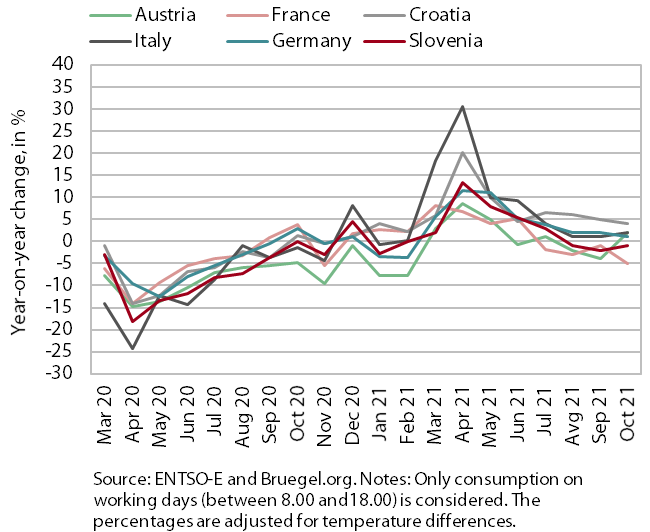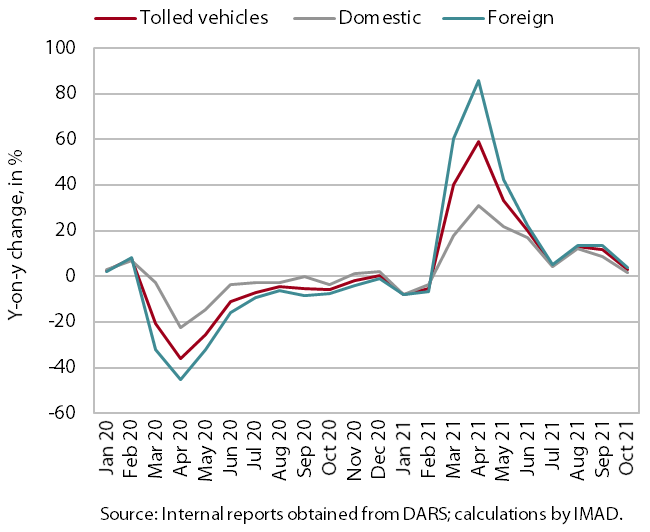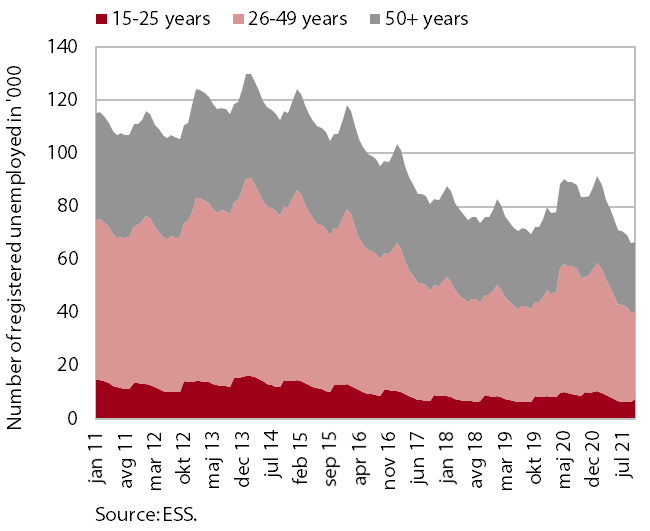Charts of the Week
Current economic trends from 2 to 5 November 2021: turnover based on fiscal verification of invoices, electricity consumption, traffic of electronically tolled vehicles and other charts
The values of some current indicators are strongly influenced by their low level in the same period last year. Thus, turnover based on fiscal verification of invoices in the second half of October was as much as a quarter higher year-on-year. Electricity consumption was roughly on par with the same periods in 2019 and 2020, while the year-on-year growth in freight traffic volumes on Slovenian motorways slowed somewhat. The monthly increase in the number of unemployed in October largely reflects seasonal trends related to a higher inflow of first-time job seekers into unemployment. Compared to last year, however, youth unemployment has declined. The number of unemployed fell by a fifth compared to the previous year and by almost a tenth compared to October 2019.
Turnover based on fiscal verification of invoices, October 2021

According to data on the fiscal verification of invoices, total turnover between 17 and 30 October was 25% higher year-on-year and 2% higher than in the same period of 2019. Compared to the previous two weeks, year-on-year growth picked up in all activities, mainly due to low turnover last year following the declaration of an epidemic and the introduction of restrictions on the sale of goods and services. The highest increase in year-on-year growth was recorded in activities that were almost completely shut down during this period last year (accommodation and food service activities, travel agency activities and arts, entertainment and recreation). Turnover in food and beverage service activities as well as accommodation and sports activities was also higher than in the same period of 2019, partly due to the redemption of vouchers. Turnover in trade was also 2% higher than in the same period of 2019, while turnover in creative, arts and entertainment activities, travel agency activities and gambling and betting activities lagged behind that period by about 40%.
Electricity consumption, October 2021

Electricity consumption in October was similar to the same period in 2019 and 2020. It was only about 1% behind these two periods. Among Slovenia’s main trading partners, Austria and France recorded lower consumption than in October 2019 (3% and 1% respectively), while consumption in other countries was higher (1% in Italy, 2% in Germany and 4% in Croatia). Compared to October last year, consumption was higher in most of Slovenia’s trading partners - 1% in Germany, 2% in Italy and as much as 4% in Croatia. In the latter country we believe the increase is due to a better autumn tourism season than last year (also due to the base effect). In France, consumption was down 5% year-on-year in October, mainly due to weather-related power outages.
Traffic of electronically tolled vehicles on Slovenian motorways, October 2021

Freight traffic on Slovenian motorways was up only 3% year-on-year in October, mainly due to one working day less. The year-on-year growth was associated with lower traffic at the beginning of the second wave of the epidemic last year. The volume of freight traffic was a few percent lower than in October 2019, but after adjusting the data for working days, it was almost 2% higher than in October 2019.
Registered unemployment, October 2021

The number of unemployed rose slightly in October, mainly due to seasonal trends related to a higher inflow of first-time job seekers into unemployment. At the end of October, 66,654 people were unemployed, 0.8% fewer than at the end of September and 20.3% fewer than a year earlier. The number of unemployed people decreased (by 8%) also compared to the end of October 2019. According to seasonally adjustment data, the number of unemployed at the end of October was 1.7% lower than at the end of September, in line with the decline seen in recent months. Although more young people (first-time job seekers) registered as unemployed in October, as is the case every year, there were significantly fewer unemployed young people (under 25) at the end of October than last year and also fewer than at the end of October 2019. The latter was influenced, among other things, by demographic trends (decline in the number of young people) and the high demand for labour, which is also reflected in the historically high vacancy rate.
